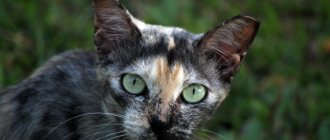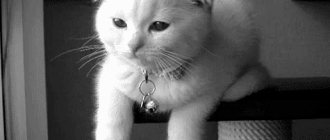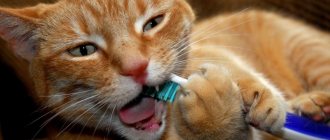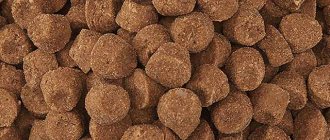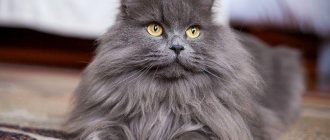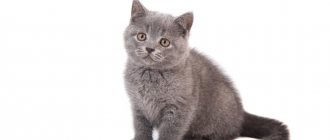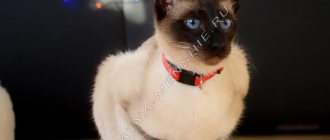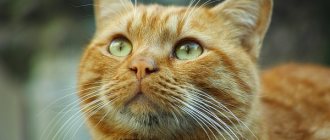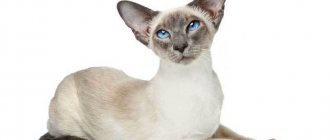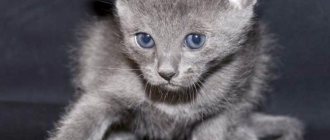Home » Cat Breeds
Sweet plush British cats, the only owners of “Cheshire” smiles among the entire cat tribe, resemble soft toys, and especially bear cubs. The standard of this breed allows a large number of colors (according to the latest data, more than sixty). Chocolate color is relatively new and still rare.
- 2 What is color and how new colors are developed
- 3 History of the breeding of British chocolate
- 4 Chocolate color standards for the British
4.1 Table: EMS encodings according to international standards WCF and FIFe
- 7.1 Video: British chocolate kitten
Who are the British
All representatives of the British breed, regardless of color, are distinguished by a rather massive and muscular physique. The body is compact, round and very harmoniously designed, with a wide, large chest and slightly short, strong legs. The average weight of males is 6–8 kg, but sometimes reaches 10 kg. Females are much smaller and lighter.
British cats have a massive build
The British have a large round head on a massive neck, with thick convex cheeks and a firm, pronounced chin. The ears are straight, medium-sized, and set wide apart. The eyes are large, round and well open. The tail is not distinguished by its outstanding size; at the base it is thickened to a rounded tip and slightly narrows. The coat is extremely thick and short with good quality undercoat and is very soft and pleasant to the touch.
Chantilly-Tiffany
This is a relatively rare breed that received official recognition in 1979. Chantilly Tiffanys are slender, graceful cats with a wedge-shaped head, bright eyes and wide-set round ears. The entire body of these animals is covered with elegant, silky fur, completely devoid of undercoat. As for color, previously these were exclusively brown cats. But the modern standard allows for the presence of lilac, blue or spotted-striped skins.
These playful and friendly animals quickly become attached to their owners. At the same time, they do not require constant attention and complex specific care. Chantilly Tiffanys often purr in a quiet, gentle voice, reminiscent of a dove's coo.
What is color and how are new colors developed?
The color of a cat refers to the color of the coat and the pattern on it. In general, domesticated cats are distinguished by an incredible variety of colors, unlike their wild relatives. There are not so many main genes responsible for the color of a mustachioed pet (solid color, lighteners, patterns, etc.), but their combination and various combinations create an endless number of options. Two genes are responsible for each trait, one of which is received from the mother, the other from the father. The task of a competent breeder is to correctly identify the necessary genes (dominant or recessive) and carefully select them to develop the desired shade.
English names
Sweet-sounding and beautiful nicknames of English origin are popular among all pet lovers. They “look” very gracefully on representatives of the cat family and are perfect for chocolate beauties and beauties.
Male names:
- Archie;
- Billy;
- Benny;
- Bean;
- Binks;
- Buddy;
- Brian;
- Brighton;
- Dave;
- Dick;
- John;
- Joel;
- Jas;
- James;
- Zach;
- Ethan;
- Kevin;
- Clyde;
- Clark;
- Lionell;
- Michael;
- Marilyn;
- Matt;
- Matthew;
- Murphy;
- Nick;
- Austin;
- Ozzy;
- Pipe;
- Floor;
- Peter;
- Randall;
- Rick;
- Ron;
- Steve;
- Sam;
- Tim;
- Volume;
- Walt;
- Frank;
- Harley;
- Chase;
- Chuck;
- Eddie;
- Angel.
Female names:
- Andi;
- Iris;
- Becky;
- Brittany;
- Barbie;
- Wendy;
- Winona;
- Valley;
- Gabby;
- Grace;
- Dolly;
- Deyzhi;
- Jodie;
- Zoe;
- Kelly;
- Kylie;
- Catherine;
- Kitty;
- Katie;
- Lizzie;
- Lisa;
- Meryl;
- Mandy;
- Miley;
- Maggie;
- Nora;
- Paris;
- Priestley;
- Singing;
- Polly;
- Prudence;
- Reese;
- Riley;
- Rand;
- Sally;
- Sue;
- Sadie;
- Tera;
- Trixie;
- Trisha;
- Tyra;
- Franny;
- Phoebe;
- Heidi;
- Hayley;Cheryl;
- Shannon;
- Sharon;
- Ashley;
- Emily;
- Ellie;
- Andrea.
Young Prudence
History of the breeding of British chocolate
Breeders were not involved in the targeted breeding of brown fur in British cats . This color is not so common; it is characteristic of eastern representatives of the cat family (Burmese, Oriental, Siamese, etc.). The goal of the breeding work was to obtain color-point color in plush cats, for which they were crossed with color-point Persians.
The purpose of breeding the breeders was the color point color, and the chocolate color turned out to be an accident
The first chocolate Briton was born by chance in the 80s of the last century. But the color was so deep and luxurious that later breeders began to strive for a pure dark brown shade. British cats of this color are very popular.
Havana brown
The ancestors of this breed are considered to be Thai and Siamese cats, which were crossed with suitable short-haired species. As a result, Miranda von Ullman, Anne Hargreaves and Mrs. Fisher managed to develop a new breed in the 50s. These cats were first presented at a British exhibition in 1959.
Source: kotsobaka.com
Features of the breed are a narrow head, large ears and green eyes. Their color is quite varied and is represented by shades of brown. These cats are distinguished by high intelligence and exquisite grace. Interestingly, this breed received its name in honor of Cuban cigars due to its similar color.
Chocolate color standards for the British
There are very strict requirements for the chocolate color of British cats. According to the breed standard, the coat should be short and soft, but the structure should be elastic and not adhere to the animal’s body. A coat that is too soft and tight-fitting to the body or, conversely, a coat that is too harsh are considered serious faults. Due to the thick undercoat, the cat’s skin becomes plush, but excessive fluffiness is unacceptable.
The coat color should be a uniform deep and rich dark brown. Each hair is painted in one tone without play or flow along its entire length. The skin and undercoat are the same shade. The nose is only chocolate, but perhaps a little lighter than the main brown tone. The pads on the paws are also in dark chocolate tones. No stains, stripes, scorches or other effects are allowed by the standard. The animal must have an exceptionally even brown color, which is sometimes called chestnut, associating this color with the color of the ripe horse chestnut fruit. The saturation and density of the shade can vary from the color of a children's milk chocolate bar to a dark chocolate bar with a high cocoa content.
The coat of a Chocolate Briton should be colored evenly, without stripes, spots, marks, etc.
The color of expensive Havana cigars, which are also a rich dark brown, gave these Britons the nickname Havana.
The irises of the chocolate British are allowed only in yellow variations: from light copper to deep dark orange. Without the greenish rim often found in cats.
Chocolate Britons only have yellow eyes
Table: EMS encodings according to international standards WCF and FIFe
| Sign | Code | Name | |
| Breed | BRI | British shorthair | British Shorthair |
| Coat color | b | chocolate (brown, chestnut) | smooth brown or chestnut (chocolate) |
| Tail length | 54 | longy) | normal/long tail |
| Iris color | 62 | yellow, golden | yellow, golden, orange |
| Ears set | 71 | straight ears | straight - straight ears |
The darker and richer the chestnut color of the fur, as well as the brighter the eyes, the more valuable the cat is.
Nicknames from the fashion world
Luxurious representatives of the feline tribe with fur in shades of coffee and chocolate are perfect nicknames inspired by the world of design and style. Here you can use the names of famous couturiers and even the names of fashion brands.
We recommend watching: 375+ French names for dogs
Our offers:
- Armani;
- Bosco;
- Baldinini;
- Versace;
- Versus;
- Gabbana;
- Gautier;
- Galliano;
- Gucci;
- Dior;
- Jacobs
- Jeanpaul;
- Yves;
- Christian;
- Kors;
- Cardin;
- Lacroix;
- Laurent;
- Miuccia;
- Muger%
- Missoni;
- Noguchi;
- Paco;
- Prada;
- Rabanne;
- Ralph;
- Saintloran;
- Ermes.
"Stylish" handsome Galliano
Anomalies and features inherent in the British chocolate color
The chocolate color is somewhat difficult to breed. Quite often, kittens are born in litters with residual stripes or spots, as well as with lightened undercoat. Which does not meet international standards, since the wool must be dyed evenly and uniformly. In addition, it is not immediately possible to understand exactly what shade of chocolate and what quality it will be.
At a certain period of time, the babies’ fur turns brown, acquiring an ugly yellowish-dirty hue. In most cases it goes away over time, but not always. Usually, only when the kitten reaches 12–15 months, and sometimes later (up to two years), does the complete development of color occur.
Chocolate British cat kittens do not immediately acquire their true color
Yorkie cat personality
York chocolate cats are distinguished by their good disposition and balanced psyche. They are unobtrusive and self-sufficient. The Yorkie cat does not like to be left alone; she constantly needs the company of a person, his presence in the house. With complete lack of attention, Yorkies can become so bored that they end up getting sick.
Cats of this breed will accompany the owner and participate in all his affairs, whether he likes it or not. For this character trait, the Yorkie Chocolate is often called a companion cat.
These animals are full of dignity and require an attentive and courteous attitude towards their person. Most of them enjoy human company, but are not keen on excessive affection. Many cats will not go into your arms or sit on your lap if they don’t want to at the moment.
They treat animals quite loyally, including dogs and small rodents. Yorkie cats are also friendly towards children, but this does not mean that they will be offended.
Like many other breeds, Yorkie chocolates are wary of accepting anything new and unknown, such as strangers or other pets.
As a rule, they choose a high place with a good view and from there they watch the newcomers. Having decided that there is no danger, they very quickly adapt to the new environment.
It is worth noting that Yorkie cats do not show aggression towards other animals even during play, so they are often kept with other pets.
Special rules for caring for British dogs with chocolate skins
Caring for chestnut-colored animals is no different and consists of the following actions:
- Proper nutrition (varied and balanced). Both feeding options are acceptable: ready-made factory feeds of at least super premium class (preferably holistic);
- natural food
- against fleas - shampoos, drops, collars, etc.
Any violations in the maintenance of the animal and health problems immediately reduce the quality of the British coat. The wool loses its natural shine and becomes dull.
"Delicious" nicknames
Gastronomic nicknames are an interesting option for furry pets with brown fur. We offer you some ideas for inspiration:
- Icecream;
- Almond;
- Anise;
- Amaretto;
- Brownie;
- Baileys;
- Brandy;
- Wispa;
- Whiskey;
- Granita;
- Guinness;
- Genie;
- Ginger;
- Iris;
- Ginger;
- Toffee;
- Coffee;
- Cappuccino;
- Canella;
- Cocoa;
- Cola;
- Klav;
- Curry;
- Latte;
- Mint;
- Minta;
- Melissa;
- Steam table;
- Mousse;
- Mocha;
- Nougat;
- Nats;
- Piper;
- Raizn;
- Spicy;
- Sweetie;
- Twix;
- Hershey;
- Chokopay;
- Eclair;
- Espresso.
Surprised Muffin
Features of genetics and mating of British chocolate dogs
It is quite difficult to obtain a real, pronounced chocolate color from a cat's fur. In order for the offspring to have a dark brown coat, a necessary condition is the presence of a certain gene in both parents . In the gene set of a chocolate baby, it must be present in double size (from the mother and from the father). That is, both parents must have the same dark brown color.
The color of an animal's fur is determined by the presence of a coloring substance (pigment) in the hairs - melanin, which is present in the hair structure in the form of varying numbers of microscopic grains (granules) of different shapes and sizes.
Kittens are born chocolate only if both parents are the same color
There are two varieties of this pigment:
- eumelanin - gives black pigmentation;
- phaeomelanin - works in the yellow and red parts of the spectrum.
Strictly speaking, there is no specific gene responsible for chocolate. When the black pigment (B) is oxidized to red-yellow, a recessive oxidized gene is obtained that colors the coat brown (b). The kitten inherits one chromosome from both ancestors, so for the appearance of a chocolate baby, the combination bb must appear.
The intensity of the shade (dilution) depends on the D gene (Dilutor - diluent). In the dominant state of this gene, the granules of the coloring pigment in the hair are tightly packed, so the color will be thick and rich. If the form is recessive, then the color turns out faded and diluted. In British chestnuts this gene is dominant (D), so their color (like blacks) is hard and dense. The recessive position (d) gives a loose color (lilac or blue).
If one of the parents does not have chocolate coloring, but is a carrier of this gene, then only half of the kittens in the litter will turn out to be chocolate . Most often, a carrier female, who does not have the required brown tint, but has this gene in her gene set, is mated with a true 100% chocolate stud male. When crossing two carriers (very often a brother and sister), a maximum of only 25% of the offspring in the litter can be chocolate. There is also a certain risk in the fact that such kittens may not turn out at all.
One litter can have kittens of different colors
Thus, the basis of selection and the greatest value are not only the real chocolate Britons themselves, but also the carriers of this gene. Since the final color of the British with chestnut coat is formed very late, you have to wait a long time. Before this, young animals cannot be used for selection.
Chocolate Britons have retained the color point color in their gene set and are carriers of this gene, so they are often used for mating with cats of this color.
A good friend of mine has a gray British cat at home. She has no pedigree, as she was bought inexpensively from some distant relatives. A cat is bred every year with the same cat found through an advertisement. A stud cat of blue color and some very good blood. Few kittens are born, usually no more than 3–4. The colors vary; there are always blue and lilac kittens in the litter. But sometimes a chocolate baby is born, to the great joy of the owner. This suggests that both the cat and the cat have the chocolate gene, that is, they are its carriers.
Video: British chocolate kitten
How much does it cost and where to buy
It is not yet possible to buy an animal of such an exotic breed in Russia. The nurseries that exist today are located far beyond its borders - in the USA and Canada.
From a trusted breeder, such a cat will cost from 150 to 500 dollars. The price of chocolate kittens depends on pedigree, gender, and compliance with the standard. A pet-class Yorkie, which is purchased as a pet, will cost the owner much less than one who is predicted to have a brilliant exhibition career.
You should not pay attention to private advertisements, since with a high probability you can buy not a chocolate Yorkie, but a purebred black kitten whose fur has simply faded in the sun. There are no official catteries of this unusual breed in our country yet.
Choosing a kitten
When purchasing an animal from a nursery, it is imperative to check the documentation and veterinary passport. Before handing over, you need to observe his appetite, activity, and examine his fur, eyes, and teeth. A healthy kitten will be playful, inquisitive and playful, like all children. Lethargy, poor appetite, dull fur, and watery eyes indicate the presence of some disease.
If the desire to buy a kitten of this particular breed is irresistible, you need to pay attention not only to health and external characteristics, but also to behavior.
It often happens that a future pet is chosen and booked based on photographs or videos posted on the breeder’s website. When the moment of the first meeting approaches, the chosen baby hides or does not show much interest in the future owner, while the other chocolate kitten is already sitting in his arms and purring as hard as he can.
The right decision would be to take the one who chose you. These animals feel a person and his character very subtly and rarely make mistakes when choosing a companion.
Peculiarities of chocolate British participation in cat shows
If a British chocolate cat exactly meets all breed standards, is healthy and has no external physical defects, and also has the necessary documents (pedigree), then it can take part in any cat shows.
Preparations for exhibition events are carried out in advance:
- The animal is bathed (if the coat looks oily) with a special shampoo. It is recommended to use conditioner (same brand).
- Clean ears and eyes.
- Carefully trim the claws.
- Using a special brush and toothpaste, brush your pet’s teeth (2-3 days before the event).
To prevent the rich brown color from fading or fading, the animal should not be exposed to direct sunlight. Tinting and tinting wool is strictly prohibited.
The show animal must meet all breed standards
Individuals with the following deficiencies are subject to disqualification:
- white inclusions, stripes, spots or lighter undercoat (brownish or gray);
- eyes of an inappropriate shade or rim around the iris;
- not brown color of the nose and paw pads;
- excess or insufficient number of fingers;
- undershot or overshot (more than 2 mm);
- tail defects (bends, creases);
- the coat is too long or very fluffy.
Our neighbor has a black cat who leads a free lifestyle. He spends most of the warm season outside, free-ranging. He comes home only to eat. Since in the summer he is often exposed to the sun, his fur fades greatly and becomes an unsightly brownish-brown color. In winter, when it is frosty outside, he sits at home and after molting again becomes blue-black.
"Fragrant" nicknames
An original solution is to give the four-legged pet a name that is consonant with the name of a classic or fashionable modern fragrance. You can also “imprint” the name of a perfumery and cosmetics brand in your nickname.
- Azzurra;
- Guerlain;
- Dolce Vita;
- Dolce;
- Givenchy;
- Zhador;
- Cacharel;
- Klima;
- Kenzo;
- Lancome;
- Mugler;
- Noah;
- Opium;
- Poison;
- Sparklin;
- Trezor;
- Tuberose;
- Chance;
- Chanel;
- Ermes;
- Angel;
- Herrera.
"Scottish" nicknamed Chanel
